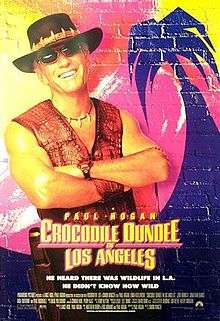Crocodile Dundee in Los Angeles
| Crocodile Dundee in Los Angeles | |
|---|---|
 Theatrical release poster | |
| Directed by | Simon Wincer |
| Produced by |
Paul Hogan Lance Hool |
| Written by |
Eric Abrams Matthew Berry |
| Based on |
Characters by Paul Hogan |
| Starring |
Paul Hogan Linda Kozlowski Jere Burns Jonathan Banks |
| Music by | Basil Poledouris |
| Cinematography | David Burr |
| Edited by | Terry Blythe |
Production company |
Silver Lion Films |
| Distributed by |
Paramount Pictures (United States) Universal Studios (International) |
Release dates |
Australia 12 April 2001 United States 18 April 2001 |
Running time | 88 minutes |
| Country |
United States Australia |
| Language | English |
| Budget | $21.15 million[1] |
| Box office | $39.4 million[2] |
Crocodile Dundee in Los Angeles (also known as Crocodile Dundee III) is a 2001 Australian-American comedy film, directed by Simon Wincer and starring Paul Hogan. It is the sequel to the 1988 film Crocodile Dundee II and the 1986 film Crocodile Dundee and the third film of the series. Hogan and Linda Kozlowski reprise their roles as Michael "Crocodile" Dundee and Sue Charlton, respectively. The film was shot on location in Los Angeles and in Queensland. Actor Paul Hogan reported that the inspiration for the storyline came during a tour of Litomyšl, Czech Republic in 1993.
Plot
At the beginning of the film, protagonist Michael "Crocodile" Dundee (Paul Hogan) is living in the Australian Outback with Sue Charlton (Linda Kozlowski) and their young son Mikey (Serge Cockburn). Because crocodile hunting has been made illegal, Mick is reduced to wrestling crocodiles for the entertainment of tourists, having as his rival in the business another Outback survivalist named Jacko (Alec Wilson). When an opportunity arises for Sue to become the Los Angeles bureau chief of a newspaper owned by her father, Mick and his family cross the Pacific to California.
In the United States, Mick and his son's encounters with the locals cause cross-cultural mishaps. Mick becomes an undercover amateur sleuth helping to probe the mysterious death of his wife's predecessor at the newspaper, while Mikey attends a local school, where he quickly impresses his classmates and teacher with his outback survival skills. Because the case takes up so much of their time, Mick and Sue eventually call in Jacko to babysit their son; Immediately, Jacko and Mikey's teacher become interested in each other.
It is revealed that the dead reporter had been investigating a film studio, which is about to make a sequel to the action film Lethal Agent, despite the title's commercial failure. Mick becomes suspicious when several paintings from Southern Europe are brought onto the set; although at first he suspects drug smuggling, the pictures themselves are revealed to be missing art from a museum in former Yugoslavia thought lost in the recent civil wars. They are to appear in the movie as mere props, to be publicly 'destroyed' in a scene in which they are set on fire, at which point they will have been exchanged for copies.
Attempting to secure one of the paintings as evidence, Mick, Sue, and Jacko run afoul of the studio director and his thugs. Using the studio's props and three lions used in filming to defeat the gangsters, Mick and Sue solve the case and return to Australia, where they are officially married.
Cast
- Paul Hogan as Michael "Crocodile" Dundee
- Linda Kozlowski as Sue Charlton
- Jere Burns as Arnan Rothman
- Jonathan Banks as Molis Drubnik
- Alec Wilson as Jacko
- Gerry Skilton as Nugget O'Cass
- Steve Rackman as Donk
- Serge Cockburn as Michael "Mikey" Dundee
- Aida Turturro as Jean Ferraro
- Paul Rodriguez as Diego
- Kaitlin Hopkins as Miss Mathis
- George Hamilton as the Coffee Colonic Guy
- Mike Tyson as Mike, the Man Meditating in Park
- Matt Winston as the limo driver
Reception
Critical reception for Crocodile Dundee in Los Angeles was predominantly negative and the film holds a rating of 11% (out of 79 reviews) on Rotten Tomatoes with the consensus "A family movie without toilet jokes, but there's nothing that haven't [sic] seen before."[3] The movie was nominated for a Razzie Award for Worst Remake or Sequel but lost to Planet of the Apes.[4]
Box office
The film grossed $7,759,103 at the box office in Australia.[5] The film debuted in 4th place at the US box office behind Bridget Jones's Diary (which was #1 in its second weekend), Spy Kids and Along Came a Spider.[6] It grossed only $39 million worldwide, well below the total gross of the previous two films.
References
- ↑ "Crocodile Dundee in Los Angeles (2001) - Box office / business".
- ↑ "Crocodile Dundee in Los Angeles (2001)".
- ↑ "Rotten Tomatoes - Crocodile Dundee in Los Angeles".
- ↑ "The Official Razzies Forum - 2001 Winners and Nominees".
- ↑ Film Victoria - Australian Films at the Australian Box Office Archived 23 July 2011 at the Wayback Machine.
- ↑ "Bridget Carries a Slow Weekend". The Los Angeles Times. Retrieved 25 December 2010.
External links
| Wikiquote has quotations related to: Crocodile Dundee in Los Angeles |
- Crocodile Dundee in Los Angeles at the Internet Movie Database
- Crocodile Dundee in Los Angeles at the TCM Movie Database
- Crocodile Dundee in Los Angeles at AllMovie
- Crocodile Dundee in Los Angeles at Box Office Mojo